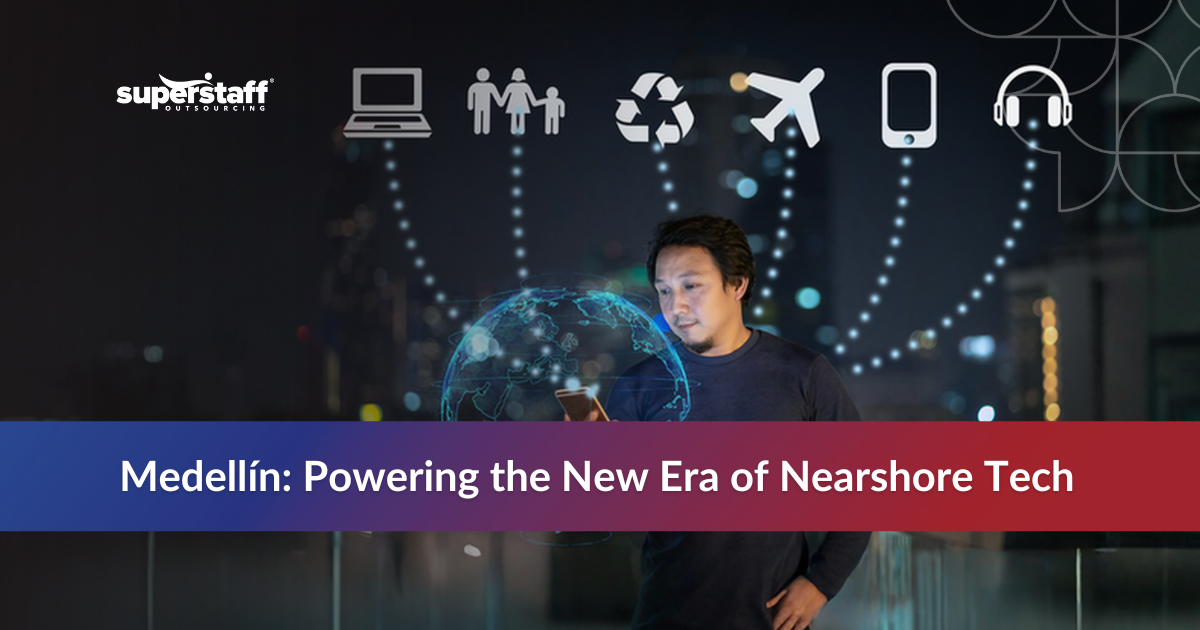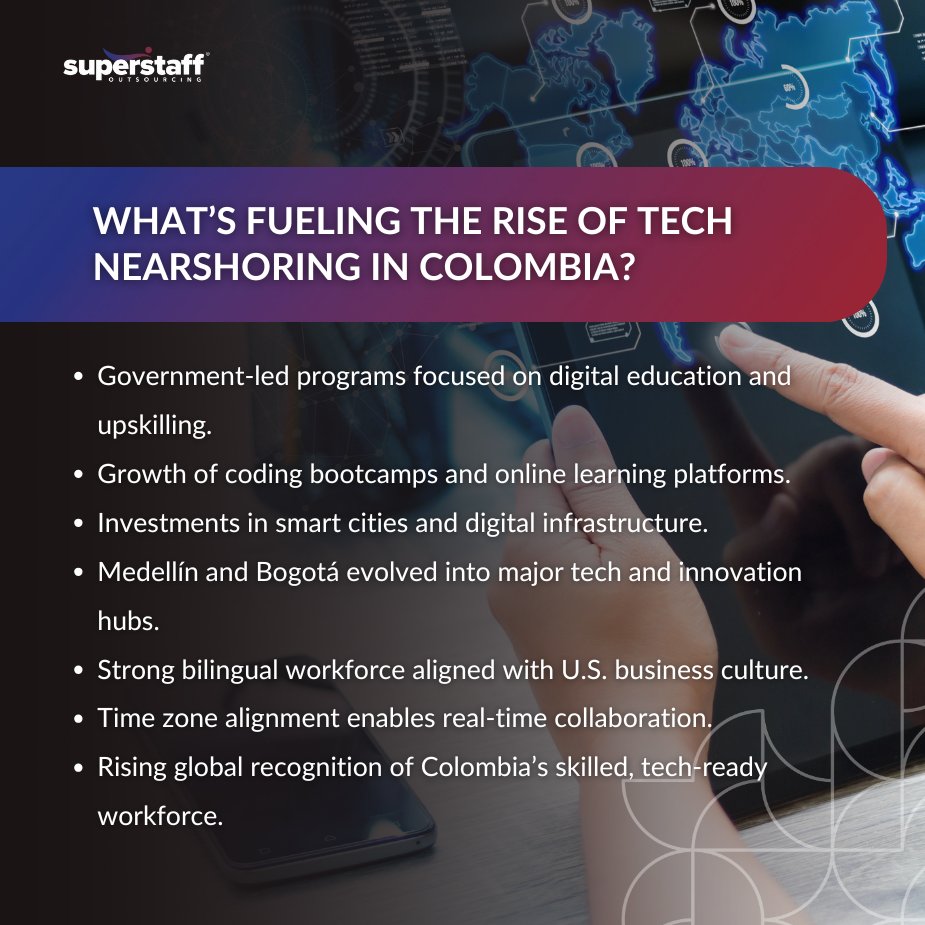
Colombia has rapidly evolved from a developing economy into one of Latin America’s most vibrant tech hubs. Once known primarily for its coffee and culture, the country is now drawing attention from global investors and tech executives alike. Over the past decade, Medellín and Bogotá have transformed into bustling innovation centers filled with startups, digital professionals, and international accelerators shaping the region’s digital future.
This transformation isn’t accidental; it’s the result of deliberate investments in education, infrastructure, and workforce development. Through national initiatives that prioritize digital literacy and bilingual proficiency, Colombia has cultivated a new generation of highly skilled engineers, software developers, and data specialists ready to collaborate with global partners.
In this blog, we’ll explore why tech nearshoring Colombia is becoming a strategic move for U.S. companies. Beyond cost efficiency, Colombia offers something far more valuable: a dynamic ecosystem that blends talent, time zone alignment, and cultural synergy. For U.S. firms seeking agility, innovation, and long-term scalability, nearshoring to Colombia isn’t just a smart operational choice; it’s a forward-looking strategy for sustainable growth.
The Rise of Colombia’s Digital Skills Revolution
Colombia’s focus on building a tech-ready workforce has transformed its economic landscape. Once regarded primarily for its agriculture and manufacturing sectors, the nation has evolved into one of Latin America’s leading technology and innovation hubs. This transformation didn’t happen overnight—it was the result of deliberate, forward-thinking policies designed to strengthen the country’s digital capabilities and attract global partnerships.
At the heart of this transformation are large-scale education initiatives like “Misión TIC 2022” and the programs of SENA (Servicio Nacional de Aprendizaje), which have trained hundreds of thousands of Colombians in programming, software development, and digital literacy.
“Misión TIC 2022” alone aimed to produce 100,000 new software developers within two years, setting the tone for a nationwide digital upskilling effort. These programs have democratized access to technical education, empowering youth across both urban and rural regions to participate in the global digital economy.
Colombia’s universities have also become active players in the country’s tech evolution. Institutions such as Universidad de los Andes and EAFIT have established partnerships with global tech leaders like Microsoft, Google, and IBM to integrate advanced IT and AI training into their curricula. These collaborations bridge academic theory and real-world application, ensuring graduates are job-ready and aligned with global standards.
Beyond traditional education, the private sector has stepped in with coding bootcamps and online learning platforms that make tech education more accessible. Organizations like Holberton School, Platzi, and Laboratoria have emerged as crucial training grounds for developers, data analysts, and UX designers. Together, these efforts are producing a digitally fluent workforce—one capable of supporting the complex needs of international clients seeking Colombia nearshore IT services.
These educational initiatives have not only expanded Colombia’s talent pool but also drawn international attention. The result is a nation positioned at the center of the tech nearshoring Colombia conversation, ready to serve as a strategic partner for U.S. firms looking to innovate efficiently and cost-effectively.

Medellín and Bogotá as Emerging Tech Powerhouses
Medellín and Bogotá are the beating heart of Colombia’s digital transformation. These two cities have undergone massive shifts over the past decade, evolving from regional business centers into internationally recognized tech and innovation powerhouses.
Medellín, once defined by its industrial history, has earned the moniker “Silicon Valley of Latin America.” The city has invested heavily in urban innovation, sustainable development, and digital infrastructure. Projects like Ruta N, the city’s innovation district, have positioned Medellín as a hub for research and development (R&D). Multinational companies—including Accenture, Globant, and Rockwell Automation—have established a presence here to tap into the city’s growing pool of skilled professionals.
Meanwhile, Bogotá, the capital city, leads as Colombia’s financial and IT outsourcing capital. It houses over 60% of the country’s technology companies and serves as the headquarters for fintech startups, cloud computing firms, and e-commerce innovators. With a population exceeding 8 million, Bogotá’s workforce is diverse, well-educated, and highly connected.
Both cities benefit from government and private investments in smart city and connectivity projects. Medellín’s MetroCable system, for example, integrates sustainability and technology, while Bogotá’s 5G rollout and digital infrastructure investments enhance its competitiveness for global firms. The result is a modern, connected environment that supports nearshore operations at scale.
Together, these cities offer a perfect mix of talent, innovation, and business readiness—making them prime destinations in discussions around why U.S. tech firms are choosing Bogotá and Medellín for nearshore operations.
Nearshore Advantages for U.S. Tech Companies
Nearshoring to Colombia gives U.S. companies strategic advantages that extend well beyond cost efficiency. In an era where speed, collaboration, and flexibility define success, Colombia offers all three.
One of the strongest advantages is time zone alignment. Colombia’s working hours overlap with the United States, allowing for real-time communication and project management. This is particularly valuable for software development, IT support, and agile project delivery, where synchronous collaboration ensures faster iteration and issue resolution.
Another major draw is the country’s bilingual workforce. Many professionals, especially in Medellín and Bogotá, are fluent in English and familiar with Western business practices. These bilingual developers in Colombia bridge linguistic and cultural gaps, ensuring seamless coordination between U.S. teams and nearshore partners.
Cultural alignment further strengthens this relationship. Colombian professionals share many values with their North American counterparts, such as accountability, innovation, and teamwork. This alignment minimizes friction and enhances collaboration across remote and hybrid teams.
But perhaps the most underappreciated advantage is Colombia’s innovation mindset. The country’s digital ecosystem encourages creativity and entrepreneurship, fostering a culture where developers and IT specialists don’t just execute—they innovate.
Beyond operational alignment, U.S. companies are drawn to Colombia’s tech communities because they represent the future of nearshoring: a partnership built on mutual growth, shared knowledge, and long-term innovation.
Innovation Hubs and Startup Ecosystems Fueling Growth
Colombia’s startup scene is fueling creativity and collaboration across borders, redefining what it means to build tech ecosystems in emerging markets. Innovation hubs across the country—especially in Medellín —are bringing together entrepreneurs, investors, and policymakers to accelerate business growth and digital innovation.
Ruta N in Medellín stands as one of Latin America’s most successful innovation ecosystems. The hub supports over 400 tech startups and has helped attract more than 300 international companies to establish operations in the region. It provides funding, mentorship, and research opportunities, driving collaboration between academia, industry, and government.
The presence of international accelerators and incubators has also helped Colombian entrepreneurs access global markets. Initiatives like Seedstars and 500 Startups Colombia have introduced a pipeline of local talent to global investors and mentors.
This strong innovation culture creates an environment where nearshored teams can thrive alongside global tech partners. It’s a dynamic ecosystem where creativity and execution meet—one that U.S. firms can plug into through Colombia nearshore IT services partnerships.
Why Colombia Stands Out in Latin America’s Nearshoring Boom
Among Latin American nations, Colombia stands out for its unique balance of stability, skill, and innovation. While Mexico, Argentina, and Costa Rica have long been players in the nearshoring arena, Colombia’s combination of affordability, education, and forward-thinking governance sets it apart.
Competitive labor costs make Colombia an attractive alternative for U.S. companies looking to maximize budgets without compromising quality. Yet cost is only part of the story—Colombia’s workforce also brings a strong foundation in software engineering, cybersecurity, and data science.
The nation’s digital infrastructure has rapidly matured. High-speed internet coverage now extends across major cities and much of the countryside. With 5G expansion underway and robust data centers in Medellín and Bogotá, the country offers the connectivity and reliability required for global tech operations.
Colombia’s political and economic stability also play a critical role in its appeal. The government actively supports foreign investment through tax incentives, simplified business regulations, and trade agreements with the United States. Agencies like ProColombia and Invest in Bogotá guide foreign investors through the process, ensuring a smooth setup and integration.
These strengths position Colombia as a long-term nearshoring destination that can evolve alongside global technological trends. As the global nearshoring boom continues, Colombia’s proven resilience and skilled talent pool make it a standout partner for innovation-driven U.S. companies.
Building the Future: Education, Inclusion, and Innovation
The foundation of Colombia’s digital revolution lies in inclusive and future-ready education. Recognizing that true transformation requires accessibility, the government and private sector have expanded digital learning opportunities across regions and social classes.
Efforts to include rural communities in the digital revolution have accelerated. Through programs like “Computadores para Educar” and regional digital inclusion campaigns, the government is ensuring that students from underserved areas gain exposure to technology early on.
Public-private partnerships are driving advanced skill development in AI, cybersecurity, and cloud computing. Companies like Amazon Web Services (AWS), Oracle, and Google are collaborating with Colombian institutions to offer certification programs and cloud labs that meet global standards. These initiatives don’t just train workers—they prepare them for international collaboration.
The culture of lifelong learning has also taken root. Professionals continue to upgrade their skills through digital platforms and online universities, ensuring that Colombia’s workforce remains globally competitive. This ongoing commitment to learning and inclusion ensures that Colombia’s nearshore advantage will only strengthen over time.
As these initiatives expand, Colombia’s position as a hub for bilingual developers and globally aligned tech professionals grows stronger. The future of Colombia nearshore IT services will be shaped by this constant cycle of innovation, education, and collaboration.
Tech Nearshoring Colombia: Your Firm’s Gateway to Digital Transformation
Colombia’s digital skills revolution has transformed it into a strategic nearshoring destination for U.S. tech firms. From large-scale education reforms to innovation districts in Medellín and Bogotá, the nation has redefined what it means to compete in the global digital economy.
Medellín’s entrepreneurial ecosystem and Bogotá’s fintech and IT leadership reflect the country’s readiness to take on large-scale, high-value projects for U.S. clients. Meanwhile, a bilingual, tech-savvy workforce provides cultural and operational alignment that few other regions can match.
For U.S. companies seeking a trusted partner in innovation, tech nearshoring Colombia offers the perfect balance: cost efficiency, collaboration, and creativity. The momentum is already here, and those who act now stand to gain not only operational advantages but a long-term foothold in one of the world’s fastest-growing digital economies.
U.S. tech firms looking to scale efficiently and innovate faster should explore SuperStaff Colombia’s thriving digital hubs, Medellín and Bogotá, as their next strategic partners.
Get in touch with us for more information on our tech nearshoring solutions!






